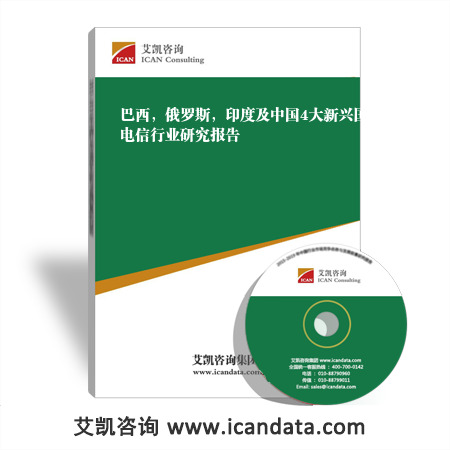数据来源与研究方法:
- 对行业内相关的专家、厂商、渠道商、业务(销售)人员及客户进行访谈,获取最新的一手市场资料;
- 艾凯咨询集团对长期监测采集的数据资料;
- 行业协会、国家统计局、海关总署、国家发改委、工商总局等政府部门和官方机构的数据与资料;
- 行业公开信息;
- 行业企业及上、下游企业的季报、年报和其它公开信息;
- 各类中英文期刊数据库、图书馆、科研院所、高等院校的文献资料;
- 行业资深专家公开发表的观点;
- 对行业的重要数据指标进行连续性对比,反映行业发展趋势;
- 通过专家咨询、小组讨论、桌面研究等方法对核心数据和观点进行反复论证。
报告简介:
 摘要
摘要
razil, Russia, India and China are regarded as the four biggest emerging markets. Between the end of 2001 and the end of 2007, BRIC nations added 660 million new mobile subscribers, 40% of the world's total new subscriptions. These countries represent enormous opportunities for you whether you are an operator, manufacturer or content distributors, you must benefit from establishing business in these regions. Can you afford not to?
The BRIC countries are amongst the most populous in the world and therefore have great potential for subscriber expansion. Many areas in the region in question also remain untouched in terms of mobile penetration. What can your company do to take advantage of these markets?
Many areas around the world, such as Western Europe have become stagnant markets with decreasing opportunities for mobile expansion. BRIC however is only just being discovered by operators and manufacturers. How long can you afford to remain away from BRIC? Companies can not hesitate making a decision whether or not to carry out business in these countries.
Revenue opportunities are only going to increase as more people look to purchase mobile phones, whilst operators are also looking to roll-out 3G services. Companies are also exploring the possibilities of offering mobile TV in these areas. Network infrastructure is continually being built and upgraded which in turn will lead to increased subscription levels and revenues. Can you afford to be miss out on the new emerging revenue opportunities?
This latest report provides valuable information to operators, manufactures, content distributors and equipment providers alike. Reading this report will provide you with answers to the following questions:
* What technology exists in the respective markets?
* What opportunities exist for foreign companies?
* Which companies will be most beneficial from the rising economic success of the BRIC nations?
* How long will mobile phone companies continue to prosper?
* What potential obstacles will operators and manufacturers face?
* What strategies should operators use to increase revenue and subscriber base?
* What regions within the BRIC nations will be the most profitable?
You really need to get to grips with this opportunity before you get left behind. Act today and order your copy of this innovative report.
目录及图表
1. Introduction
1.1. BRIC Thesis
1.1.1. Dreaming With BRICs: The Path to 2050 Table 1.1: US and BRIC Stock Markets Growth in Returns 2002-2007 1.1.2. Economic Potential Table 1.1: World Rankings in 2050 Chart 1.2: Largest World Economies by 2050 1.1.3. Criticisms of Goldman Sachs BRIC Thesis 1.1.4. Potential for Mobile 1.2. Focus of the Report 2. Brazil 2.1. The Brazilian Market Figure 2.1: Regions of Brazil 2.1.1. Mobile Background Chart 2.1: Brazil Mobile Subscribers, Q1 2007-Q1 2008 Chart 2.2: Brazil Mobile Subscribers Percentage Share, March 2008 2.1.1.1. Risks in Brazil 2.1.2. 3G Licenses Table 2.1: Licenses Acquired in Brazil 3G Auction (December 2007) 2.2. Company Profiles 2.2.1. Vivo Table 2.2: States That Vivo Operate In Chart 2.3: Vivo Subscribers, Q1 2007 - Q1 2008 Table 2.3: Vivo Service State Details (End 2007) Chart 2.4: Vivo Customer Area Distribution 2.2.1.1. Activity in 3G Auction Table 2.4: Licenses Acquired by Vivo in 3G Auction 2.2.1.2. Vivo Product and Service Information 2.2.1.3. Acquisitions 2.2.1.3.1. Telemig Celular 2.2.1.3.2. Amazonia Celular 2.2.1.3.2.1. Amazonia and Oi 2.2.2. TIM Chart 2.5: TIM Mobile Subscribers, Q1 2007-Q1 2008 Chart 2.6: TIM Subscribers, 2008-2013 Table 2.5: Brazilian States Benefiting From 3G Services 2.2.3. Claro Table 2.6: Countries Served by Claro Table 2.7: Regions Covered by Claro
2.2.3.1 Huawei
2.2.4 Oi
2.2.4.1 Brasil Telecom
Table 2.8: Regions Covered by Brasil Telecom
2.2.5 Nextel Brasil
Table 2.9: States Where Nextel Brasil Operates
2.3 Brazil Overview
Chart 2.7: Brazil Economic Growth 2005-2008 3. Russia
3.1 The Russian Market
3.2 Mobile Background
Chart 3.1: Russia Mobile Subscribers, 2002 - 2007 Chart 3.2: Russian Mobile Subscriber Share, May 2008 Chart 3.3: MTS and VimpelCom Minutes Used, Q3 2006 - Q3 2007
3.2.1 Value Added Services
Chart 3.4: Russian Revenue Distribution from VAS, May 2008 Chart 3.5: Russian Revenue from VAS for Year 2007
3.2.1.1 Mobile Advertising in Russia
3.2.2 Blackberry
3.2.3 3G Auction
3.3 Company Profiles
3.3.1 MTS
Chart 3.6: MTS Shareholders
Table 3.1: Countries Provided by MTS Service Chart 3.7: MTS Subscribers, Q1 2007 - Q1 2008 Chart 3.8: MTS VAS Revenue, Q1 2007 - Q1 2008
3.3.1.1 Bashcell
3.3.1.2 MSS
3.3.1.3 Mobile TV
3.3.2 VimpelCom (Beeline)
Table 3.2: Countries Where Beeline Services Are Available Chart 3.9: VimpelCom Shareholders, Q1 2008
3.3.2.1 CSK
3.3.2.2 Ericsson
3.3.2. Golden Telecom
3.3.3 MegaFon
Table 3.3: Companies Acquired by North-West GSM to Become MegaFon Chart 3.10: MegaFon Shareholders Chart 3.11: MegaFon Revenue 2008 - 2013
3.3.3.1 Nokia Siemens
3.3.4 Tele2 Russia
Table 3.4: Regions Covered by Tele2 Russia Figure 3.1: Tele2 Russia Coverage Map
3.3.5 Tele2 Russia
3.3.5.1 Eniseitelecom
Table 3.5: Operators That Can Exchange MMS With Tele2 Eniseitelecom
3.3.5.2 Adygey Cellular Telecommunications
3.4 Russia Overview
4. India
4.1 The Indian Market
4.1.1 Mobile Background
Chart 4.1: India Mobile Subscribers, 2002-2007
4.1.1.1 Mobile TV
4.1.1.2 Value Added Service
4.1.1.3 Targeting Rural Areas
4.1.1.3.1 Basic Handsets
Figure 4.1: Spice Sabka S-300
4.2 Company Profiles
4.2.1 Bharti Airtel
Chart 4.1: Bharti Airtel Subscription Types, April 2008 Chart 4.2: Bharti Airtel Revenue Distribution, April 2008 Chart 4.3: Bharti Airtel VAS Distribution, April 2008
4.2.1.1 iPhone
4.2.1.2 Super Lifetime Pre-paid
4.2.1.3 Tower Company
Chart 4.4: Indus Towers Rights' Owners
4.2.2 Reliance
4.2.2.1 CDMA and GSM
4.2.2.2 MTN
4.2.3 Vodafone Essar
Chart 4.5: Vodafone Essar Shareholders
Table 4.1: Regions Covered by Vodafone Essar
4.2.4 BSNL
4.2.5 Tata Indicom
4.2.5.1 Novarra
4.2.6 Idea Cellular
Table 4.2: Areas Covered by Idea Cellular
4.2.7 Other
4.2.7.1 Aircel
4.2.7.2 MTNL
4.3 India Overview
5. China
5.1 The Chinese Market
5.1.1 Mobile Background
Chart 5.1: China Mobile Subscribers, 2002-2007
5.1.1.1 Olympics
5.1.1.2 Mobile TV
Table 5.1: Chinese Mobile TV Standards
Chart 5.2: Success of Fixed-Line and Mobile in China Chart 5.3: Mobile Subscriber Distribution in China (Post Restructuring)
5.2 Company Profiles
5.2.1 China
5.2.1.1 China Mobile
Chart 5.4: China Mobile Revenue 2006-2007 Chart 5.5: China Mobile Subscribers 2005-2013
5.2.1.1.1 China Mobile VAS
Chart 5.6: China Mobile SMS Sent 2006-2007
5.2.1.1.2 Joint Innovation Lab
5.2.1.1.3 3G
5.2.1.1.4 China Tietong Telecommunications Corp
5.2.1.2 China Unicom
Chart 5.7: China Unicom Share Division
Chart 5.8: China Unicom CDMA - GSM Usage
5.2.1.2 China Unicom VAS
5.2.1.2.2. China Netcom Merger
5.2.1.2.2.1 China Telecom
5.2.1.3 Huawei
5.2.2 Hong Kong and Macau
5.2.2.1 Mobile TV in Hong Kong
5.2.2.2 CSL New World Mobility Group
Chart 5.9: CSL New World Mobility Group Share Division
5.2.2.2.1 CSL Value Added Service
5.2.2.3 3 Hong Kong
Chart 5.10 : 3 Hong Kong Ownership
5.2.2.3.1 3 Hong Kong and iPhone
5.2.2.4 SmarTone-Vodafone
Chart 5.11: SmarTone Revenues
Chart 5.12: SmarTone-Vodafone ARPU 2007-2008
5.2.2.5 PCCW
Chart 5.13: PCCW Types of Subscriber
5.3 China Overview
5.3.1 The Olympic Challenge
6. Conclusion and Recommendations
6.1 Recommendations in Brazil
Chart 6.1: Brazil Mobile Subscribers 2008 - 2013
6.1.1 For Operators
6.2 Recommendations in Russia
Chart 6.2: Russia Mobile Subscribers 2008 - 2013
6.2.1 For Operators
6.2.2 For Content Distributors
6.3 Recommendations in India
Chart 6.3: Indian Mobile Subscribers 2008 - 2013
6.3.1 For Operators
6.3.2 For Manufacturers
6.4 Recommendations in China
Chart 6.4: Chinese Mobile Subscribers 2008 - 2013
6.4.1 For Operators
6.4.2 For Manufacturers
About visiongain
Companies Listed
3 Hong Kong
AD AG
Aditya Birla Group
Adygey Cellular Telecommunication
Aircel
Alcatel-Lucent
Alfa Group
Amazonia Celular
America Movil
Americel
Anatel
Apollo Hospital Enterprise
Apple
ATL
BaikalWestCom
Band Internacional
Bashcell
BCP
Beijing Nufront Software Technology
Beijing Organising Committee
Bharti Airtel
Brasil Telecom
BSNL
Cartoon Network
China Association for Standardisation
China Mobile
China Netcom
China Telecom
China Tietong
China Unicom
Claro
Claro Digital
CMMB
CSK
CSL New World Mobility Group
CT-Mobile
Eniseitelecom
Ericsson
ESPN Brasil
FSB
Golden Telecom
Goldman Sachs
Google
HTIL
Huawei
Hutch Essar
Idea Cellular
IFC
Indus Towers
IPOC International Growth Fund
Maxis Communications Berhad
MegaFon
MegaFon
MGTS
Microsoft
Ministry of IT and Communications
Mobicom
Motiv
Motorola
MSS
MTN
MTNL
MTS
MTV
NEC
Nextel Brasil
NII Holdings
Nizhny Novgorad Sotovoya
Nokia
Nokia Siemens Networks
North-West GSM
Novarra
NTT DoCoCom
Oi
Paggo Empreenimentos
PCCW
Portugal Telecom
Povolzhie
Qualcomm
Reliance Captal
Reliance Communications
Reliance Energy
RIM
Samsung
Siemens
Sistema
SK Telecom
SmarTone
SmarTone-Vodafone
SMARTS
Softbank
Sonera Holding
Sonic Duo
Spartak Moscow
Spice Telecom
STEK GSM
Tata Group
Tata Indicom
Tele Norte Leste Participacoes
Tele2 Russia
Telecom Eurasia
Telecom Italia
Telecominvest
Telefonica
Telemig Celular
Telenor
Telia International
Telpart Participacoes
Telstra
Tess Cellular
TIM Brasil
TIM Participacoes
T-Mobile Deutschland
TRAI
Tsinghua University
Ulyanovsk-GSM
Unicom Group
Uralsky GSM
Utel
VimpelCom
Vivo
Vodafone Essar
Vodafone Group
Volzhsky GSM
Xanga
YouTube
ZTE
电信俄罗斯
















